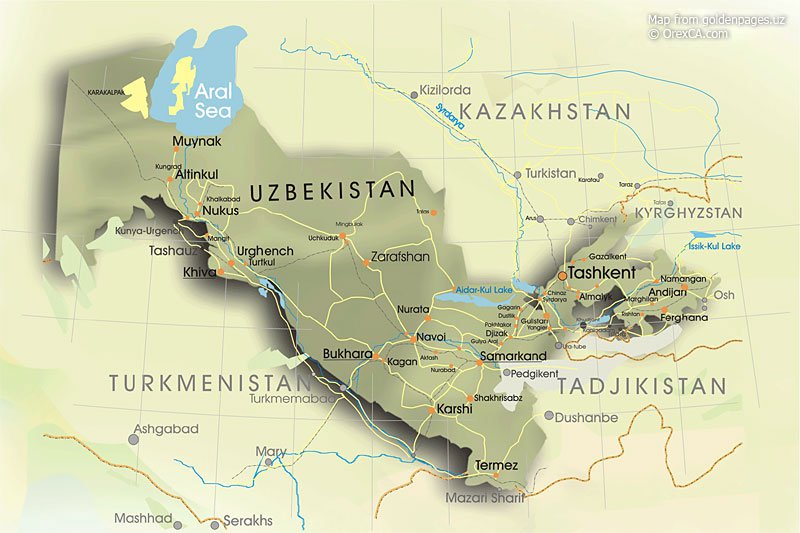Location: the Central Asia, to the south from Kazakhstan.
The country is surrounded by a land.
The note: the border passes across Aral sea
(420 km. Coasts of Aral sea).
The area:
The general – 447.400 sq. km.;
The earth – 425.400 sq. km.;
Water – 22.000 sq. km
Overland borders:
The general extent – 6.221 km.
Extent of borders about Afghanistan – 137 km., Kazakhstan – 2.203 km.,
Kirgizstan – 1.099 km., Tajikistan – 1.161 km., Turkmenistan – 1.621 km.;
Coastal line: 0 km. (Without considering 420 km. Aral sea)
Relief. The most part of territory of Uzbekistan is occupied with plains (about the four fifth territory). One of the main things is the Tourist’s Ansky plain.In the north of the central part of territory of Uzbekistan there is one of the largest deserts of the world – Kyzyl Kum.
Geological structure and minerals. Country bowels contain stocks of natural gas, brown and coal, gold, copper, tungsten, bismuth; oil fields are opened.
Climate. A country climate deserted-continental. A difference of temperatures depending on a time of year considerable enough. The average January temperature falls to-6°S, and the average July rises to +32°С. The Amount of precipitation isinsignificant, therefore agriculture in a greater degree depends on irrigation.
Internal waters. The majority of the rivers of Uzbekistan dry up in the current, only Amu Darya and Syr-Darya run into Aral sea. In Uzbekistan there are some large artificial lakes, such as the Chardarinsky water basin.
Soils and vegetation. On plains there is the deserted vegetation, in mountains – steppes, woods, mountain meadows prevails.
Fauna. The country fauna is rather various: in desert there is a rare antelope a saiga and a monitor lizard reaching lengths of 1,5 m. In mountains the snow leopard and rare species of mountain goats lives.
Range. Mountains and foothills make about 1/5 territories of republic. In the east prevail average and high-mountainous forms of a relief: slopes enter into republic limits or the terminations of ridges of Western Tjan-Shanja (ridges Ugamsky, Pskemsky, Chatkalsky, Kuraminsky) and Pamiro-scarlet (ridges Zeravshansky, Turkestani, Gissarsky, Kugitangtau, Bajsuntau). To the south and the West, they gradually go down and pass in plains. Between mountains big hollows are stretched: Kashkadarinskii, Surkhan-Darya, Zeravshansky, Samarkand. The largest intermountain hollow is the Fergana hollow (valley) – 370 kilometres, and at width reaches 190 kilometres. From three parties it is framed by mountain ridges and only from the West it is opened. On border with Afghanistan there is an extensive Priamudarinsky hollow.
Natural resources. The republic Uzbekistan possesses the big industrial and mineral-raw potential, unique agricultural raw materials, considerable volumes of the half-finished products received in the course of processing, the rich natural resources, the developed infrastructure.
Modern level of investigation of minerals is connected with development of the richest deposits of the noble, colour and rare metals, all kinds of organic fuel – oil, natural gas and a gas condensate, brown and to a floor of coked coal, combustible slates, the uranium, many kinds of raw materials for building materials.
In Republic Uzbekistan the wide complex of minerals including about 100 kinds of mineral raw materials from which 60 are already used in a national economy is revealed.
On the confirmed stocks of such minerals as gold, uranium, copper, natural gas, tungsten, potash salts, phosphorites, Uzbekistan takes leading places not only in the CIS, but also all over the world. So, on stocks of gold the republic takes the fourth place in the world, and on level of its extraction the seventh place, on copper stocks – the tenth – the eleventh place; uranium – the seventh – the eighth place, and on its extraction – the eleventh – the twelfth place.
Available stocks of mineral raw materials in the majority not only provide operating mining complexes on long prospect, but also allow to increase capacities, again to organise extraction of some the major minerals – gold, uranium, copper, lead, silver, lithium, phosphorites, potash salts, fluor-spar, agrochemical ores, etc.








